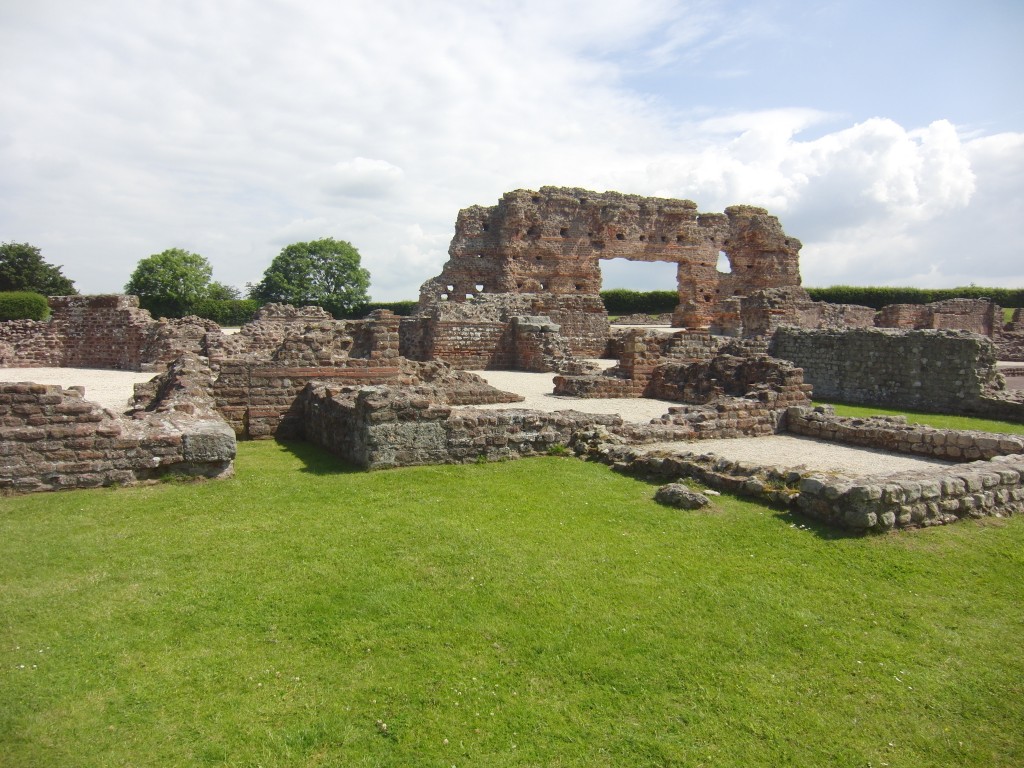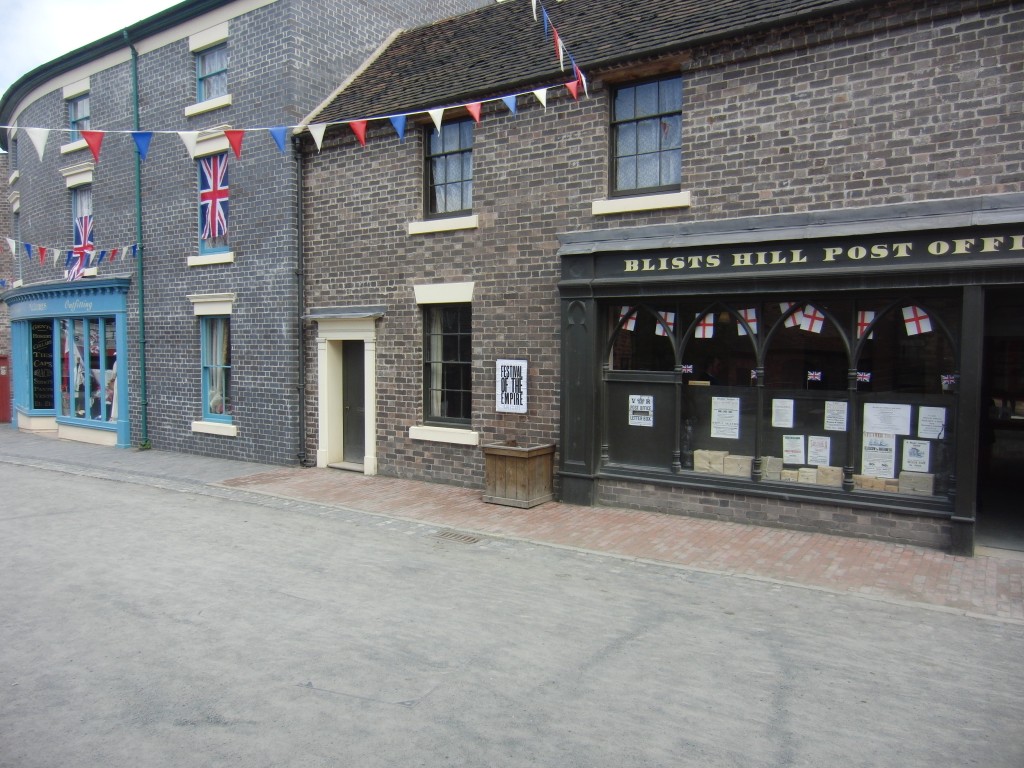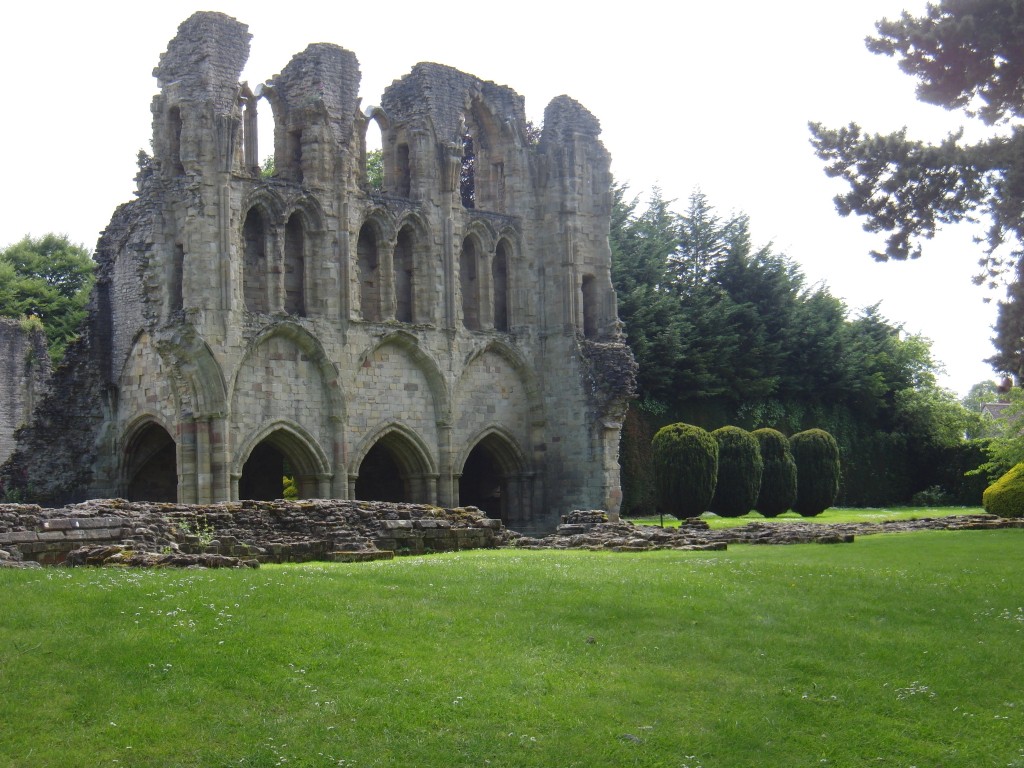Romans and Victorians (and Ruins)
Wednesday, June 13th
We woke up this morning to blue skies! Even though it did rain on us twice, it was definitely a lovely day. We started out our morning at Wroxeter Roman Town. It’s a partially excavated town (mostly the baths) and it’s also got a modern Roman villa. The original Roman town was HUGE. It was first a fortress, then a town, then housed soldiers again, then disappeared and no one knows why. It goes all the way underneath the nearby town of Wroxeter, and we noticed that English Heritage owned all the sheep fields around the Roman City, so we figure that it’s underneath all the fields as well.
One really fun thing – when we drove in, we did not take the main way (by mistake) and ended up on this TINY little road. We could have stuck our hands out of the windows and both touched hedges on the same time. Well, when we got to Wroxeter, we figured out why. One of the reasons Wroxeter is so darn big is because it was built along Watling Street, a Roman road that went all the way to Rome. The street we drove in on is built over Watling Street.
The site itself is pretty neat. It is the excavated (and sufficiently restored to not come crumbling down) ruins of a giant Roman bath house. There was the foundations and column supports of the indoor exercise arena, which was about 75 yards long, and then there was a lot of the front entrance wall to the actual baths remaining, as well as foundations for the cool, warm and hot rooms, the furnaces, and the nearby market stalls.

The view from the visitor center. The red was where the wall was, the white gravel shows the inside of basically a huge Roman gymnasium

The largest piece of wall remaining. The large doorway would have been from the gym area into the baths proper.

The stacks of brick in the foreground are part of what is called a hypercourse. The floor would have been built on top of these bricks, and hot air fanned in underneath, for central heating. In the hottest rooms, they also had hollow bricks in the walls, so that the heat could go up the walls as well.

More Romans! Taken standing outside of the baths, where they think there was a row of rather fancy shops. Tiny, but apparently for selling jewelry and perfume and so on.
Across the street from the excavated ruin is a pretty cool project – they took 6 modern builders, and gave them the raw materials that the Romans had, and said “Build a villa!” They had to make their own tools, cut their own wood, make their own A- frames to lift all the stuff, and so on. They’re still working on some of it, but it was cool to see how they built it, and how a real building might have looked, because it’s hard to imagine such enormous buildings from just tiny walls.

The re- made Roman Villa. The thing in front is another part of the ruins, running right along the Roman road, which is right under the modern road.
After Wroxeter, we went on to nearby Blist Hill. Blist Hill and the general area of Irongorge are interesting because they are one of the very first truly industrial places. Blist Hill had (has) three giant blast furnaces, that allowed them to smelt and work iron on a huge scale. The blast furnaces are large enough to probably contain a small two story house in each one. They are fed with air by this giant double pump called David and Sampson. It’s a steam powered bellows, and the bellows themselves are probably a full 20 feet high. The flywheel for this thing stuck out the top and bottom of a 3 story shed thing. At the center of all of this is the foundry itself, where they purified and worked the iron ore coming out of the nearby mine. Iron could be heating to melting, poured into molds, and if they didn’t feel like pouring it, they could hammer on it with a steam hammer that took 5 people to work. Let me rephrase – the things they were hammering took 5 people to control. The hammer… well, it weighs some 20 tons, without the force of the steam behind it. Doubt any one person could control it.

The blast furnaces for the foundry. They do not look as huge in this picture as they should look. They are huge.

(not my picture. do not know where picture went. suspect ghosts) The giant bellows for the foundry. The red tubes on the far right are the actual air- chambers. All the stuff to the left of the stairs is the mechanism for working them. Note the giant fly wheel!

(not my picture. Do not know where picture disappeared to.) This is the giant hammer. They weren’t smelting on the day we were there, but they still work this thing.
There is also a clay mine, and tile, brick and china factories in the nearby area. But one particularly cool thing is that they have re- done the little town to how it would have been in the Victorian era when all the mining and so on was in its heyday. So they had all the shops open and people were selling things and making things, and there were little historical things all over. You could change your money into really old English money, with ha’pence, and shillings, and it was very confusing, but kind of fun. We went into the bakery, the apothecary, the post office, the tinsmith, the bank, the forge, the haberdashery, the plasterer, the sweet shop, the butcher, the fish and chip shop (where Kevin got fish and chips for lunch for the 3rd day running), the printer, and a variety of other little houses and shops. There was also a very cute little Victorian style carnival, and we rode this fun double swing. It’s like a boat, and you sit facing each other, and get a rope attached to a beam way up high. By alternating pulling, you could really get the swing going.

The printer’s shop. You could get signs and things made, and they had some rather funny ones up in the windows.

Inside the chemists! This place actually featured on a BBC series about re- imagining the high street chemist of Victorian times. I liked it.

One of the streets in Blist Hills, and the post office! There was a secret postal museum-let above the post office.

Part of a little carnival down on the green. We went on the swings! You sit opposite someone in a little boat thing, and you have crossed ropes, and by pulling in turns, you can get it going pretty high.
After Blist Hill, we had one more stop, at the ruins of Wenlock Priory. It is a very beautiful ruin, with flowers growing everywhere – the grass is full of daisies, and the walls were covered in places with these gorgeous little sprays of purple flowers. It was first founded as a monastery by the Saxons, and then was a college of priests, and then a priory. It was dissolved and partly torn down by King Henry VIII, in his Dissolution of the Monasteries. Nevertheless, very very beautiful. Also – what used to be the house of one of the Abbots, and is attached to the remains of one of the walls of the abbey – it’s totally someone’s house now. Seriously. Who even does that???

There were flowers growing right out of the walls all over the ruins. SO beautiful. Also – Look how thick that wall is!

The courtyard. Someone has maintained the yew tree topiary. They’re all animals, like squirrels and so on. Kevin and I decided that yew looks a heck of a lot like redwood.

The entrance to the chapter house. Totally carpeted with daisies! Also, see that roof in the back on the right? Remember that…
















Sounds like you are having a ball. Love the skinny back roads. Good for you!
Good for you. Sounds like you are having a ball. Nice work on the old skinny road.